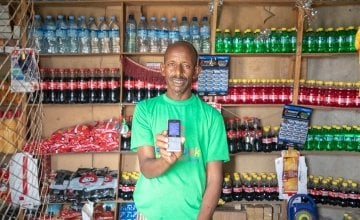
Knowledge Hub
For a number of years, Concern and other development organisations have increasingly provided humanitarian assistance in the form of cash to achieve their objectives: in our case, ending extreme poverty, whatever it takes. But how does cash and voucher assistance work, and why is it vital for efficiency, quality of response and value for money in the aid sector?
As the nature of humanitarian disasters changes, pushing more people into poverty for longer, how we respond needs to change too. Over the past years, new approaches to protect the lives of those affected by crises – short and long-term – have been trialled, with cash assistance proven to be one of the most effective at both saving lives and making limited funds go further.
How does it work?
Cash assistance is delivered through cash transfers or the provision of a voucher. The term ‘cash transfer’ means assistance in the form of money - either physical currency or electronic cash - to individuals, households or communities. Vouchers are provided in paper, token or electronic form. They can be either cash vouchers, which have a cash value (e.g. £15) and can be redeemed for goods up to that value, or commodity vouchers, which can be redeemed for a specific quantity of certain goods and services, (e.g. 5kg of maize). Or, they can be a combination of the two.
There are different ways of delivering cash transfers and vouchers, such as smart cards, mobile money transfer, cash in hand, bank transfers, electronic vouchers and paper vouchers.

The ‘flexible friend’: why is it so effective?
In our experience, where it is possible and appropriate to provide cash assistance, there are more positive outcomes than traditional assistance provided in kind. For example, cash assistance can be more efficient as it is fast, flexible and adaptable. The amount, time and duration of disbursement can be scaled quickly to respond to an emergency and longer-term recovery needs or to restore livelihoods, and at lower costs.
Another big benefit of giving cash and vouchers is its value for money. For example, cash and vouchers provided in response to the 2011/12 Somalia famine delivered over twice more aid to beneficiaries compared to traditional food aid because of the savings on transport, storage, handling and security costs [DFID].
However, in addition to operational gains, cash assistance is preferable because it puts vulnerable people’s immediate needs first, while also allowing space for long-term development. People are empowered with the choice to purchase what they value most – be it food, shelter, household supplies or medical assistance – therefore gaining access to a wider range of commodities. Moreover, looking at the wider impact, cash transfers can stimulate the local economy and strengthen local markets as the money is usually spent locally. Cash is not only a way of helping people get back on their feet, it incentivises and supports entrepreneurship, enabling them to take control of their own futures.
Cash and the East Africa crisis
East Africa is experiencing one of its worst droughts in recent history, with more than 28 million people facing life-threatening hunger across Ethiopia, Kenya, Somalia and South Sudan.
When 260,000 people, half of them under the age of five, died of hunger and related conditions in the 2011/12 drought, the global community said ‘never again’. History is now repeating itself on a much larger scale and thousands of avoidable deaths could be the catastrophic consequence of a delayed or inadequate response.
We are responding to this urgent crisis by:
- Treating tens of thousands of children and adults suffering from severe malnutrition, diarrhoea, cholera, measles and other illness.
- Providing emergency food, water and hygiene kits to areas most in need.
- Repairing and constructing boreholes, wells, latrines and handwashing stations.
- Vaccinating livestock against diseases and providing emergency feed.
And, we are providing cash to families so they can buy food and other essential items. This cash assistance means that families like Lowiriyen's can provide for themselves.

Lowiriyen's family lost their goats due to the drought and they were left with nothing. Her 18-month-old child became malnourished as a result. As well as receiving treatment for her child at a Concern-supported clinic, for the past three months, Lowiriyen has received a monthly emergency cash transfer from Concern, which she mainly uses to buy food for her family. It also allows her to set some money aside for the future in the local savings and loans association.

I appreciate the support I receive from the cash transfer. It allows me to live again and not have to worry about how I am going to feed my child - for a few months, at least. I set aside some money from the cash I receive so that when the help stops I will have something to rely on.
The purpose of development is to help people in poor countries become independent and stand on their own two feet. Cash assistance, with self-reliance at its heart, does just that.
Lives are on the line, right now. Please give what you can.
Other ways to help
Donate now
Give a one-off, or a monthly, donation today.
Join an event
From mountain trekking to marathon running, join us for one of our many exciting outdoor events!
Buy a gift
With an extensive range of alternative gifts, we have something to suit everybody.
Leave a gift in your will
Leave the world a better place with a life-changing legacy.
Become a corporate supporter
We partner with a range of organisations that share our passion and the results have been fantastic.
Create your own fundraising event
Raise money for Concern by organising your own charity fundraising event.





